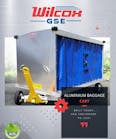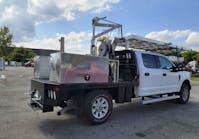Safety culture in the aircraft ground handling environment is supported by effective safety training. In this update on the Asia Pacific region, we have reached out to industry experts for an overview of the relationship between safety culture and safety training, the peculiarities of safety culture in the region, and how safety training and culture are being continuously improved.
Effective safety culture and training
An effective safety culture is built on core principles that must be actively championed by both leadership and the frontline workforce and, affirms Brad Moore, Swissport International CEO for Asia Pacific. “It requires consistent demonstration of trust and a genuine commitment to prioritizing safety. Establishing strong organizational foundations to support a safety culture is crucial for success," he says.
According to Wilson Kwong, chief executive of Hactl, aircraft handling is a potentially dangerous and high-risk business, because the ramp is busy and fast-paced, it involves numerous unrelated operators working side by side, as well as working on and around expensive aircraft assets.
“In most physical handling jobs, on-the-job training plays a key role; but, given the hazards of the live ramp, this is challenging," he says. “We resolved this problem some time ago by employing Virtual Reality (VR) to simulate the ramp environment, enabling new recruits to gain some familiarity with their tasks before entering the live scenario.
"We have found that very helpful, and it is popular with new staff who find it prepares them well for the reality of their work."
At Swissport, supporting the safety culture is achieved by implementing a comprehensive safety management system (SMS) that defines clear responsibilities and accountabilities, focuses on proactive risk management, emphasizes training and competency, and fosters leadership commitment, explains Moore.
“Additionally, teamwork, collaboration, a just culture for reporting, and a continuous learning and improvement cycle are essential elements. This structured approach enables leaders to uphold a safety culture that prioritizes minimizing risks to protect both people and equipment, while ensuring adherence to regulatory standards," he says.
“Ongoing improvement initiatives, along with open communication and consultation with our workforce, are central to maintaining this culture."
Personnel must understand the hazards of their working environment and must develop a safety-first attitude, according to Kwong.
“At Hactl, we have invested a great deal of time and resources on promoting safety culture: For example, staging an annual Safety Week in which we engage staff through interactive quizzes and fun activities, in order to deliver serious messages," he says.
“We operate our own in-house training courses, tailored to our specific needs, using a dedicated on-site training center, and employing highly experienced trainers."
According to Moore, safety training is a fundamental element of an organization’s SMS, as it not only supports but also strengthens the safety culture by fostering a proactive mindset focused on protection.
“When a workforce is trained to prioritize the safety of both people and equipment, it helps build trust and accountability," he says. “A robust SMS relies on training to equip workers and leaders with the knowledge and skills needed to identify and manage risks. This training fosters awareness and encourages proactive behaviors that mitigate potential hazards. It also helps cultivate a non-punitive reporting culture, where employees feel safe to report issues without fear of blame. This, in turn, promotes consistency across the organization and reinforces its core values of safety and accountability."
Safety culture in the Asia region
While aviation safety is a global matter policed by global standards, there are some peculiarities within the Asia region where many airports such as Hong Kong are very large operations with high volumes of flights, passengers and cargo, observes Kwong.
“So, the resulting pressures on staff and resources can be very considerable, particularly at peak times, when aircraft turnrounds are really tight. It is an inherent feature of Chinese culture to respect authority and to carry out instructions to the letter. This means that, given a robust safety eco-system such as that of Hactl, with all necessary checks and procedures in place, we can be confident that this will be implemented constantly and rigorously," he says. “In addition, we find our staff are very receptive to any opportunity to improve their knowledge and skills, and are therefore very ready to participate in regular training and refresher courses."
At Swissport Asia Pacific, actively listening to frontline employees is essential for fostering a positive safety culture and improving understanding of the risks they face, declares Moore.
“This open communication encourages greater employee participation in identifying and solving safety challenges," he says. “For example, in South Korea, employees openly report unsafe conditions and behaviors every month, and they are encouraged to offer safety suggestions during meetings. This transparent exchange helps create an environment where safety concerns are addressed proactively."
Swissport also places emphasis on effective communication between management and staff, explains Moore.
“We ensure that safety messages are consistently communicated across all levels, reinforcing a ‘safety first’ culture. An additional key initiative is our local ‘Safety Walks’ program, where teams of staff members conduct regular safety checks together. This collaborative effort helps maintain high safety standards and ensures that everyone goes home safely at the end of each shift," he says. “Looking ahead, we are committed to continuous improvement through innovation. We actively explore advances in technology, ground service equipment, and work processes to minimise risks and enhance safety in ground handling."
Improving safety training and culture
In the Asia region, continuous improvement in safety culture is driven by learning from near-miss incidents and, when necessary, actual events, according to Moore. “We tailor our safety training to address real-world scenarios, ensuring that our people gain a thorough understanding of the risks involved," he affirms. “Additionally, we integrate modern technologies such as artificial intelligence into our training materials, which allows us to offer content in multiple languages to cater to our diverse workforce."
Hactl is continuing to pursue its concerted program of safety training measures, including VR Safety Training for ramp loading operations, which enhances the situational awareness of staff handling various aircraft types, affirms Kwong.
“To maintain our leading role in safety, we will keep investing and using latest technology to enhance training quality and effectiveness," he says. “This is a continuing process, and we are poised to make further announcements about safety initiatives that we believe will really grab the attention of the industry. Automation, digitalisation, big data and robotics will all play a part in future safety initiatives."
Swissport believes that both individual and organizational qualities are essential to cultivating a positive safety culture, highlights Moore.
“We expect all employees to actively contribute to promoting this culture by embodying these values in their respective work environments. This approach ensures safety remains a top priority at every level of our operations," he concludes.





